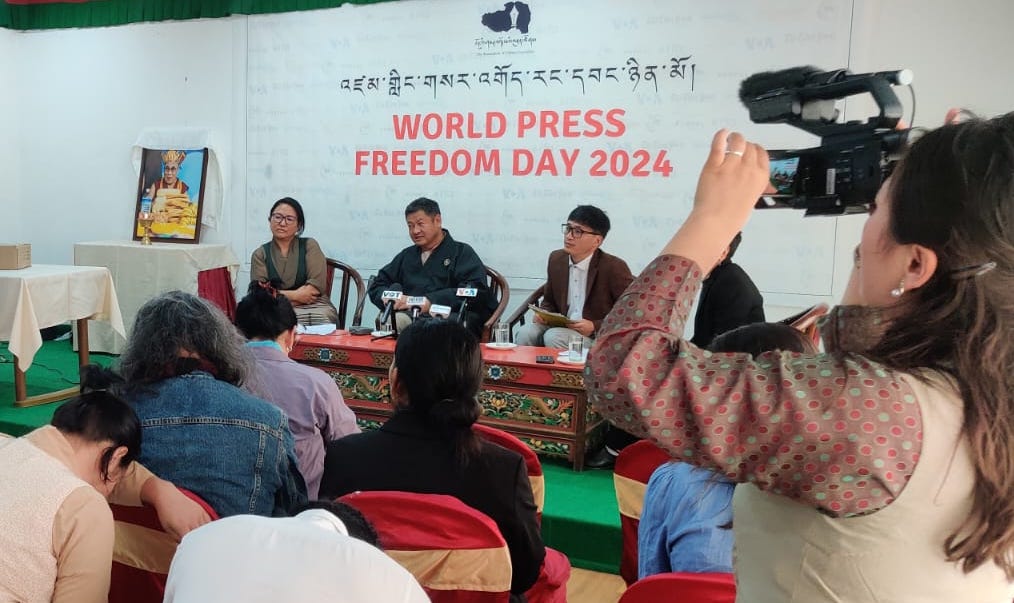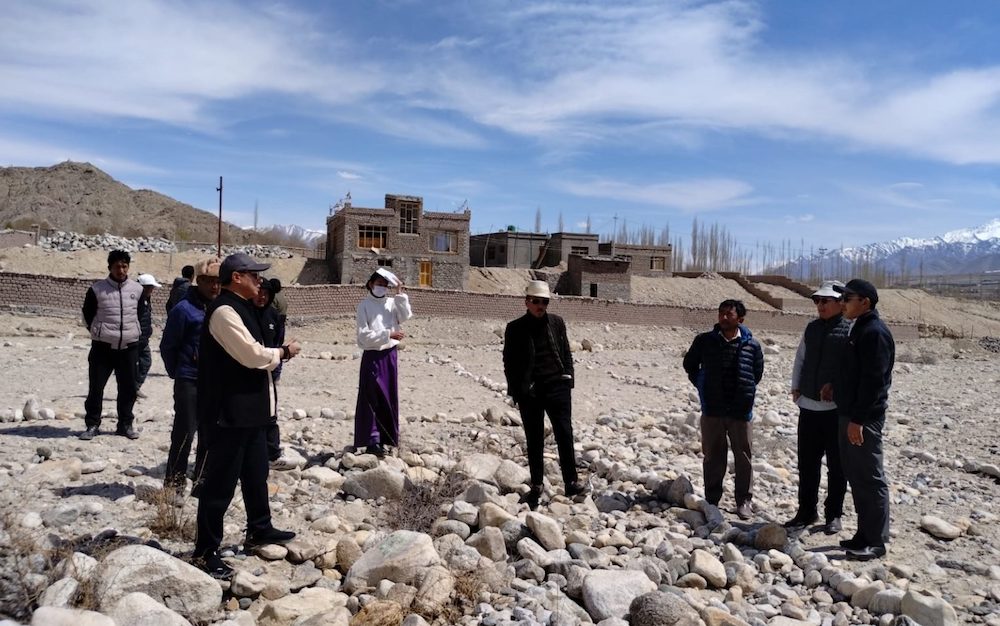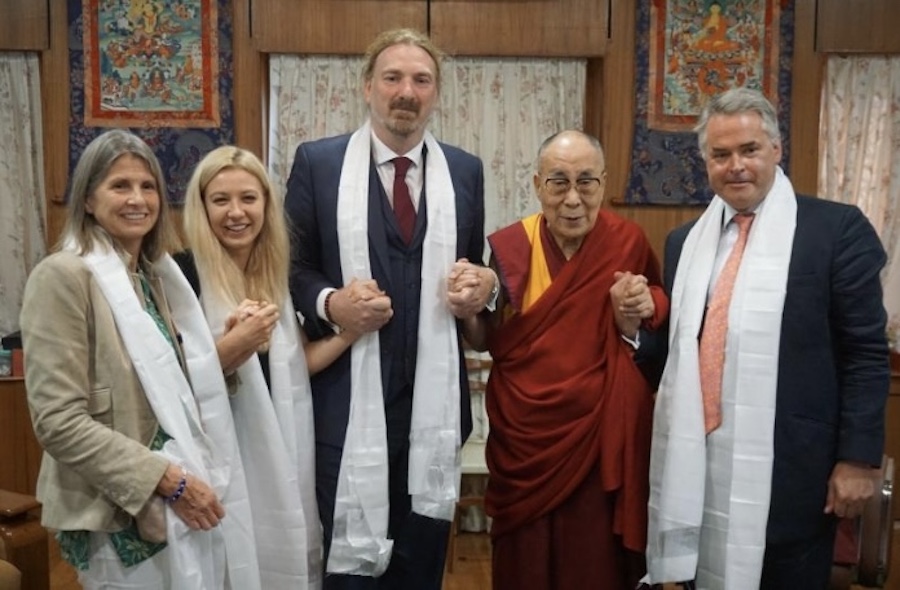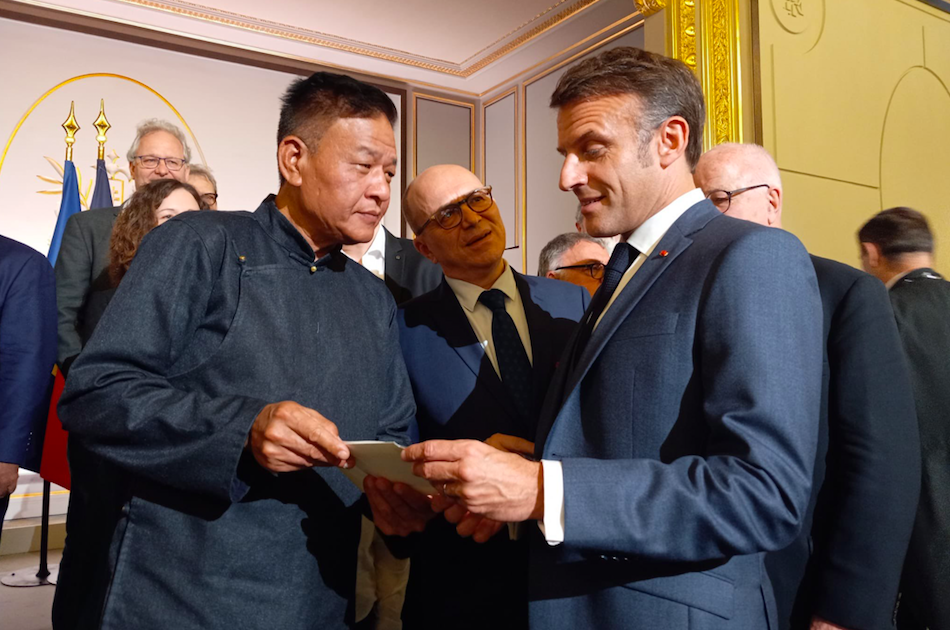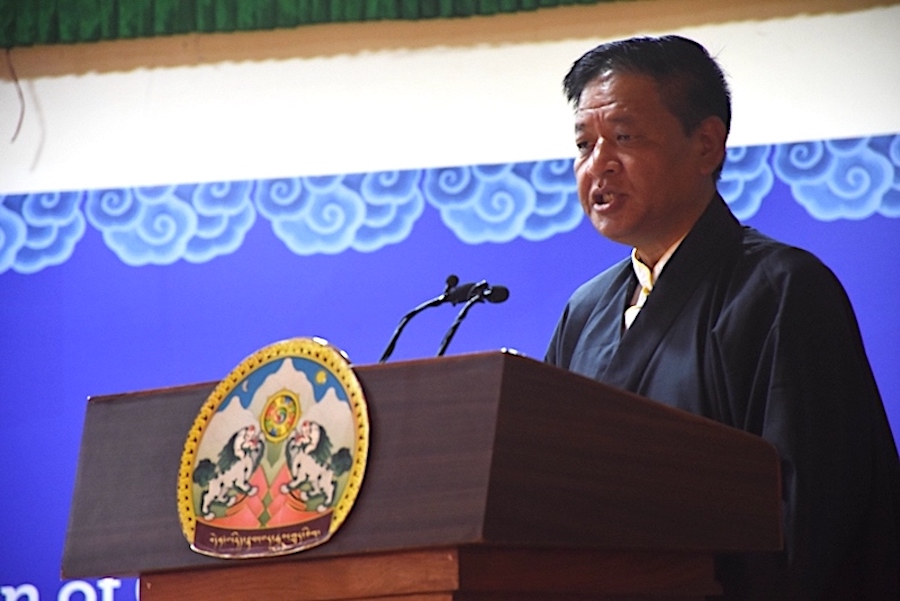By Jamyang Norbu
My mother, Lodey Lhawang (née Tethong) passed away, very peacefully, on the morning of January 9, at my home in Monteagle, Tennessee. Her daughter Rigzin Dolkar, daughter-in-law Tenzing Chounzom, grand daughters Namkha Lhamo and Namtso Kyi, and myself were at her side. We are tremendously grateful to Kyabje Trichang Rinpoche, my mother’s root lama, for his prayers and spiritual advice and the Drepung Loseling Monastery in Atlanta, Georgia, whose monks performed all the necessary prayer services and rituals at our home.
With the gradual passing away of my mother’s generation our memories of Tibet as a real living nation, with a rich and valid history and a complex human culture, will surely weaken and slip away – If we do not commit them to writing, or at least rekindle them, every so often, with loving recollection. Therefore, in memory of my mother, I would like to share with the reader this episode from her long and eventful life, which also illustrates an interesting moment in Tibetan diplomatic history.
When I was around nine years old my father took me to Dzachukha, the north-eastern limit of our frontier with Chinese-occupied Eastern Tibet. Two of the most powerful Golok chiefs were arriving there from their tribal lands further north and were to be awarded Tibetan government ranks and honours. I remember it all very clearly. The occasion was a welcome break from my normal routine of copying Tibetan alphabets on my wooden writing-board (jangshing), day after day, at Derge. I had started learning my letters a few years before and could now read whole sentences. When I was some years older and my writing had improved I was given the task of making copies of Tibetan government proclamations to circulate around the various dzongs and monasteries in Eastern Tibet. That was when the 13th Dalai Lama appointed my father, Tethong Gyurme Gyatso, governor-general of the whole of Eastern Tibet.
But at the time of my trip to Dzachukha my father was only governor of Derge and shared administrative responsibilities with his uncle, Thangpon, who was co-governor. My father also commanded the Shigatse regiment. Thangpon commanded the Dhingri regiment. The Gyangtse regiment was under Chapay. Earlier my father’s co-governor had been his cousin, Khyungram, who had by then left for Lhasa.
I was born just after the Chinese were defeated at Kanze (1918). My father and his cousin Khyungram, both dapons (generals) at the time, had successfully driven out Chinese forces from that area. Both generals were billeted at the home of an important chieftain of Kanze, Adug Lagatsang, and it was there that the Tibetan government courier (atrung) brought my father a letter from my mother, informing him of my birth in Lhasa city. Coincidentally, my uncle Khyungram also got a letter from Lhasa announcing the birth of a son to their family. As a military man I am sure my father was disappointed that his first child was a daughter, but he never so much as even hinted about that to me. He was a very thoughtful and kind person. Some of the older servants would sometimes tease me by saying how I had let down the Tethong family on that occasion. Later, I became good friends with Khyungram’s son. We were not only the same age but also cousins. Some years later when Khyungram was degraded and sent into exile because he had offended the Regent, his son, through no fault of his own, also lost his rank and wealth.
My father’s official career was mostly served in Eastern Tibet, about twenty years according to him. He wanted to return to Central Tibet but was never relieved of his duties in Kham. The Thirteenth Dalai Lama was strong-willed and expected unquestioning obedience of his officials. My father was the same age as Tharchin Babu la (the founder/editor of the Tibet Mirror Press) who was a friend of his. He married my mother, Dolma Tsering (née Rong Dekyiling) when he was twenty-seven and she only fifteen. There was an age difference of twelve years between them. Both had the same astrological sign – the tiger.
I was born two years after the marriage. Four years later, when my father made a brief visit to Lhasa from Kham my sister Tsering Wangmo was born. A year later following another visit, my brother Tomjor was born. After that the whole family moved to Eastern Tibet and my brother Rakra Rinpoche was born in Derge. My sisters Sopal, Tsering Lhamo (who died young), and Tashi were born at Derge also. A brother Migmar Thondup was born to my mother at our estate in Shigatse when my father finally got to return to Central Tibet, but this child did not live long. My youngest brother Tsewang Chogyal was born in Chamdo during my father’s last tour of Eastern Tibet.
The headquarters of the governor and the military headquarters were at Derge Changra, which is on the other side (east) of the Drichu river. Years later (in 1932 when Ngabo was governer-general) the Chinese got the upper hand in Kham and pushed us back, the headquarters were relocated to Derge Jamda, west of the river. There were two military camps at Derge, one occupied by the Dhingri regiment and the other by the Shigatse and Gyangtse regiment. The camp of the Dhingri regiment was on a hill, about a mile-and-a-half from headquarters. The camps were permanent arrangements with administrative buildings and stores located at the centre and surrounded by barracks. The governor’s residence was a large castle nearby. It was a very old structure built of rammed earth and stone. Behind the castle was a park where we had picnics and archery contests. The castle had many rooms most of which were dark and gloomy. It was a high, cold building and the governor’s offices and residence were on the top, while at the bottom were dungeons where bandits and murderers were locked up. The castle was said to be haunted.
The first person to experience this was the artist (driba) Jamyang, a stout monk from Palpung monastery who my father had hired to paint some thankas for us. He had the ability to see spirits. He stayed in a small wooden hut at the top of the castle, where the national flag was flown. One day, looking down from the roof of the castle, he noticed some strange children playing outside the Gyangtse regiment camp. They did not appear every day but whenever they did it seemed that they were playing a little closer to the castle. Finally, they came inside. Immediately after that a rash of gambling, especially of the Chinese domino game thu bai chu, broke out among the soldiers. It got so bad that a soldier even sold his rifle to pay off his gambling debts. To restore discipline my father had all offenders punished and domino sets burnt. You see, the little children were actually imps (theurang), and imps are known to be very fond of gambling. They are also mischievous and harmful.
The famous Sakya lama, Khenpo Samten Lodroe, abbot of the great monastery of Derge (Derge Gonchen), once stayed at the castle with some of his retainers to perform some religious services for us. One of his servants fell down a flight of stairs and died. The great lama became very angry and looked under the stairs as if he could see something or someone. He then ordered preparations for a fire-puja and performed a drakpoe jinsek (wrathful fire-puja exorcism) and rid the place of the malicious imps.
We later moved to the residence of Tana dapon (who died in 1927 campaigning in Powo against the feudal baron of Powo, Kanam Depa, who had rebelled against the Central Government). The house was east of the castle and on the side of a low sunny hill. It was a cheerful house, two stories high in the front and one at the back. There was a large walled-courtyard in the front where the stables and store-houses were located. Later on the building was enlarged to accommodate the office of the governor.
From this headquarters in Derge the governors kept in touch with a number of small garrisons located all along the frontier with Chinese-occupied Kham. A military outpost (sung-ja, sa-sung) manned by fifty soldiers from the Gyangtse regiment was maintained at Dzachukha. It was at this outpost where the Golok chiefs and their tribesmen were to gather to swear allegiance to the Dalai Lama and the Tibetan government, and receive official ranks and honours in return.
Our entire family accompanied my father on this expedition: my mother, my brother Tomjor, who was about six then, and another brother, an incarnate lama, Rakra Trulku, who was just a baby. They probably won’t remember anything about this journey. They were too young. I had a sister, Tsering Wangmo, who was about five, but she was in Lhasa under the care of my grandmother, from my mother’s family, the Dekyiling.
It was mid-summer when we set off. It is almost impossible to travel in those parts in winter. From Derge it took us about six to seven days to get to Dzachukha. I remember the first main stop we made was at Dankhog. I have vivid memories of the landscape on the way: steep gorges, high mountains and rivers – many rivers. It seemed to me that we were constantly fording a river or crossing a bridge, then getting to another river, crossing that and coming up against another. The names of those places were indicative of their nature – Khorlo–do, Dama–do (The "Wheel Confluence", the "Drum Confluence") and so on.
There were also gold prospectors along some stretches of these rivers. They were all poor Chinese coolies from Dartsedo, most of them opium smokers. They were employed by the governor of Derge to pan gold. The accumulated gold dust was sent to Lhasa to the Central Government. The king of Derge also had certain rights to extract gold from this area. The coolies pumped the sand up from the riverbed with equipment that looked like large tea-churns without bottoms.
On arriving at Dankhog I saw the monastery of Choengor-gon from a distance. It looked very grand and impressive, but I didn’t get to visit it. We stayed at the home of the 16th Karmapa’s father, Athup Tepo. His new house was just nearing completion, so we were lodged at his tro-khang (pleasure house), a kind of summer-house. It was designed like a Chinese temple and had a large pond with ducks and geese. We had an enjoyable stay there. Once the new house of the Athup-tsang was finished, they hosted a banquet for us. They borrowed our chef, Nyima, who was from our estate, Kharak, in Shigatse. Our major-domo, Po (Grandfather) Phuntsok supervised the whole affair. He was the maternal uncle of our maid meme Sona. I remember attending the banquet. Gyalwa Karmapa was not there. I don’t know why. Probably he was sleeping. He was just a baby then – about three. But he was famous all over Kham. His mother and father were, of course, at the dinner. Whenever they came to Lhasa they would visit us, especially Tepo. He was a quiet, sober man of eminent respectability. He didn’t have any teeth and very little hair – but he had great dignity.
Our party had a military escort of about twenty-five soldiers. That was not counting members of the band: bagpipers, drummers and buglers. The soldiers who carried the regimental flag and the large banners (tan-dung) of the protective deities were physically outstanding men. There were also those soldiers who fired the Chinese mortar (da-phor) which signalled the arrival of important officials. Nine rounds were fired to announce the arrival of the governor.
After Dankhog the landscape changed and the precipitous mountains and gorges gradually gave way to broad grassy plains. I remember galloping my pony wildly on such stretches. I had my very own pony – a small Tibetan pony (yul-ta) brought all the way from Tsang. He was called Kyangtruk or baby "kyang" (equis hemionus). He was light brown in colour. I rode him everywhere. Whenever we travelled my father liked me to dress as a boy, which I really loved doing. So I wore a man’s robe (chub-jen), boots, a charm-box (ghau), and even had a small sakchukha pistol (.22 Berreta) in a leather holster with a belt tied securely around my waist.
My friend and companion was a servant girl, Phurbu Dolma, who was probably fourteen at the time. She was later your uncle T.C’s (Tsewang Chogyal) nanny when he was a baby. Whenever we got to a flat grassy stretch Phurbu Dolma and I would race our ponies. The younger servants would shout encouragements at us. But the older servants would later scold us for our wild behaviour. On the day that our party would arrive at an important stop, all the younger servants, maids, and us children would be sent early on ahead, so that our presence wouldn’t undermine the dignity of the ceremonial arrival of the governor of Derge.
Just before reaching Dzachukha we came to the outpost of the Gyangtse regiment, manned by about fifty soldiers. The outpost, which looked like one of those US army forts in cowboy movies, came as a surprise to me. It was the only solid structure in the whole area. For the last few days all we had seen were the black tents of nomads and, and not many of them either. A little way from the fort, a large tent encampment (gar-drik) had been prepared, and a reception committee arrived to escort us there. At the centre of the encampment tent-quarters had been prepared for the governor and his entourage.
I remember my mother telling me that the next day the Golok chiefs would receive government ranks. In one of the other tents our servants were unpacking and laying out the ceremonial costumes, indicative of official rank, to be presented to the two Golok chiefs. There were the yellow zogoe brocade robes, changda hats with red silk string fringe and turquoise crest, silk belts, boots, and the gya-dri pu-shuk knives. The chiefs were not issued the sogchil ear-rings as it was mandatory that you had long hair to wear one. Even when Golok men didn’t shave their heads altogether they kept their hair short.
The next day the ceremony took place in front of a large tent called a ta-summa (three-section). This kind of tent is rectangular and has one of the longer sides open and is used mostly for ceremonial purposes. It is made of white cotton and decorated with auspicious designs. Inside the tent, the ground of which was covered with many rugs, a throne was erected and a large photographic portrait of the 13th Dalai Lama in an ornate gilt frame belonging to our family, was placed on it.
Then the two chiefs rode up and dismounted. They were dressed in the ceremonial costumes that our servants had earlier taken over to their tents, and helped them put on. The servants later told us that when the chiefs tried to mount their horses the animals became skittish as they did not recognize their masters in their new outfits. One of the chiefs nearly got thrown-off. The two chieftains were accompanied by their aptrugs (lieutenants) who were dressed in their traditional best.
One of the chiefs was a thin man seemingly in his twenties, Trulku Tendrak of Golok Arkhyong Gongmatsang, chief of the Ri-mang tribes. The other, Rinchen Wang gi Gyalpo, was a stout man in his forties of dark, bluish complexion. He was chief of the Sershul nomads. They approached the throne and prostrated before it, performing the sar-jel (audience) formalities. They offered white silk khataks to the portrait of the Dalai Lama and also to my father and the Golok lama Jampel Rolpai Lodroe who was also officiating at this ceremony. This thin, humble Gelukpa lama was respected and venerated by most Goloks. He was also well known in Lhasa for his scholarship. In fact it was his persistent advice and effort that had persuaded the two Golok chiefs that their lawless independent existence was a precarious one and that they should submit to the Tibetan government and once again become part of the nation with which they shared their religion and way of life. Jampel Rolpae Lodroe had also approached my father and, after some negotiations and letters to the Dalai Lama and the kashag (cabinet) at Lhasa, the matter was arranged to everyone’s satisfaction.
After the sar-jel formalities, the ritual for the long-life of His Holiness (mendrel-tenthoe) was performed. A proclamation from the Tibetan government was read out conferring the ranks of rimshi (fourth rank) on the two chiefs. Then our soldiers paraded to martial music from the band, and a number of rounds were fired from the Chinese mortars.
Many hundreds of Golok tribesmen and their women, the subjects of the two chiefs, had turned out for this occasion and the area around the ceremonial tent was covered, for miles around, with hundreds of black yak-hair tents. In the subsequent days, there were less and less tents, until one day there was no one else on that vast empty grassland but us. My mother told me that the tribesmen had probably gone off to raid caravans.
A mile or so from the site of the ceremony was a small solitary monastery – probably Kargyupa. It was said to be very sacred. We went to pay our respects and worship there. A few monks came out to receive us at the monastery gate. Further away was the Gelukpa, Sershul monastery, the largest in the area. The abbots and disciplinarians of the monastery, along with a ceremonial train, came out to receive us. They showed tremendous respect to my father. They were also genuinely grateful to him as he had earlier helped them to rebuild their monastery which had been largely destroyed by the Chinese. When the abbots approached us my mother remarked how they appeared to be just like abbots of the "Three Great Seats" (densa sum) of Lhasa – even wearing the special raven-eye capes, and their tse sha (the caps like Roman helmets) back to front. From the fort, the Sershul monastery was about the distance of Drepung monastery from Lhasa city, or so I thought – but I was only a child then and my sense of distance could have been wrong.
We stayed at Dzachukha for some time. My father requested a Jigje Powo Jigpa empowerment ritual (wang) from the Lama Jampel Rolpae Lodroe. Also the precious Dzochen Rinpoche passed by Dzachukha. His monastery was not very far away. He had lunch with us and talked for sometime with my father. He was somewhere between fifty-five and sixty then, and quite stout. His nose was red, but that could have been because of a cold. He was wearing a large khampa style overcoat called the ring-gag. He appeared to be a completely un-selfconscious, unworldly lama – like a real siddha. He was greatly respected by all Khampas, Goloks and other Tibetans. When his servitor came out to the corridor with his tea-cup, our servants and others crowded around to get a drop of the remains (sha) of his tea. I also got a little in my hand and licked it up. In Kham everybody is very pious and I became like that too.* I even remember kissing a flag-stone that a holy lama had just stepped on.
On our way back to Derge we once again stopped at Dankhog, but this time stayed at the Dolma Lhakang or the "Tara Temple". My father also went to visit the stupa of a very holy lama far up in the mountains, but we children stayed behind at the temple. When he returned my father presented a set of jewel ornaments to an image of Tara there. The temple had three images of Tara, one of which was said to have spoken. Our offering went to this speaking Tara. I vaguely remember the ornament having zi stones and pearls.
After that we returned to Derge.
(This account was first published in Lungta No8 (1994) as "The Conferring Of Tibetan Government Ranks On The Chieftains Of Golok", as told by Lodey Lhawang to Jamyang Norbu. It might also be noted that this account receives credible verification in Joseph Rock’s great monograph, The Amnye Machen Range and Adjacent Regions, (Is.M.E.O., Roma, 1956) Rock mentions that when he travelled across Golok territory in 1926 he was told that Arkhyong Trulku the chief of the "largest and most important" Golok tribe, the Ri-mang, was absent from his encampment and said to have gone "…to make his submission to the Tibetan government.")
* In his condolence letter my friend Tashi Tsering la mentioned this about my mother "She was very fortunate to have been ordained by no one else than Khenchen Shenga of Kham when she was only 6-7 years old in Derge. Between 1925-1936, she met and was blessed by all the leading Kagyu, Nyingma, Sakya and Geluk Lamas in Kham. She met Lamas such as the famous 11th Situ Rinpoche, the 5th Dzogchen Rinpoche, Khengen Samten Lodro of Derge Gonchen, Geshe Jampel Rolpae Lodro, Kathog Mogtsa, Khenpo Ngagga, and Khunu Lama Tenzin Gyaltsen. Later she studied with Lingka Rinpoche of Shelkar and Kyabje Phabongkha, and both the senior and junior tutors of the Dalai Lama."





